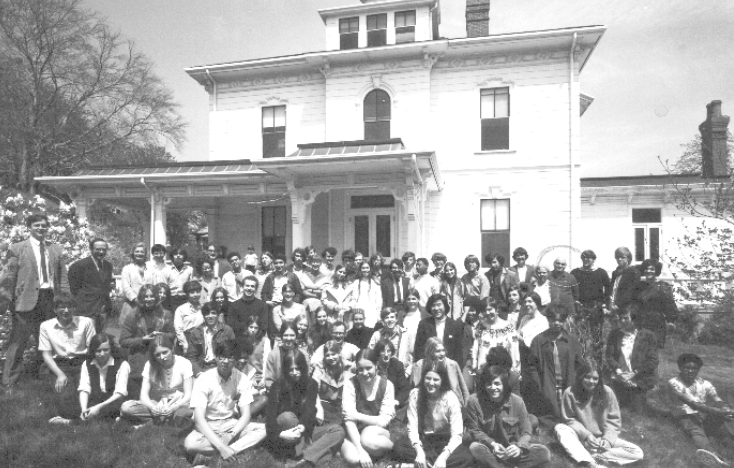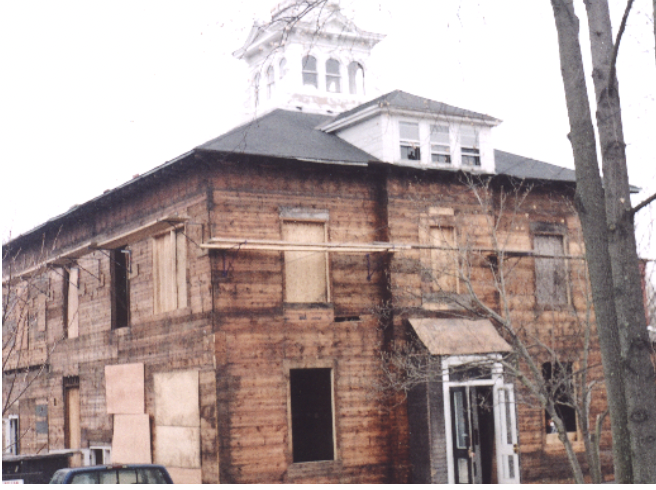
This piece is part of a series of articles on local history. This article was written by Joyce Kelly, Board member of the Historical Society of Watertown. Joyce writes articles for the newsletter and is the newsletter editor. This was published in our April 2004 newsletter, “The Town Crier.”
119 Palfrey Street
Although many of the old houses of Watertown have been demolished to make way for “progress,” a few of these treasures have been saved by caring individuals with a soft spot for days gone by and an interest in what happened in the past.
In 1982, through funds provided by the United States Department of Housing and Urban Development, the Watertown Historic Resources Inventory was compiled by employees of the Architectural Preservation Associates of Cambridge, Massachusetts. This Inventory identifies buildings that contribute to or illustrate the growth of Watertown and the development of its architecture. Two of the houses listed in this report will be discussed in this quarter’s newsletter:
You may have driven by the impressive Italianate structure at 119 Palfrey Street in the last year and noticed that it has slowly been going through major renovations. It has been bought by an individual who is turning it back into a private residence.
This gorgeous house is listed in the above mentioned Historic Resources Inventory as being built between 1850 and 1874. The construction firm that is renovating the house, J. Plante & Sons, has been able to narrow the year down. One of the beams uncovered in the house had written on it, “Napoleon Carbonneau – Carpenter, 1860.”
The house was built for George N. March, a dry goods merchant who owned a gentlemen’s furnishings business in Boston called the Reversible Collar Company and was President of the Union Market National Bank. He was one of the Founders of the bank in 1873. A Watertown Street Directory from 1882 also lists him as President of Knapp Shade Roller Co on Fayette Street.
According to Watertown Annual Reports of the late 1800s, Mr. March worked on the celebration for the Centennial at Lexington & Concord, was a Library Trustee for 20 years, and was the Library Treasurer for several of them.

Last spring Joe Plante, owner of J. Plante and Sons, the Construction Company contracted to do the renovations, showed me a beautiful wooden mantle they had taken off a fireplace in one of the rooms on the first floor. It had a large “W” elaborately carved into it. Perhaps the “W” stood for Watertown. It is evident that Mr. March appreciated and was very involved in his community.
The original property was much larger and included a formal garden and orchards. The granite wall, which surrounded the property, can still be seen on the Palfrey Street side of the house and the houses adjacent.
Following March’s death in 1895, his son and widow maintained the house and business.
Records in the Assessor’s Office at Town Hall show that the property was sub-divided in 1951. Up until then, this section of Palfrey Street was covered in woods with a scattered handful of elegant Victorian homes. At this time the building became Jeannette’s Nursing Home. The facility cared for between 15 and 20 resident patients.
In 1965, the building and the now reduced acreage were sold to Edward Ryerson. Here Ryerson founded the Palfrey Street School, an accredited coeducational day Liberal Arts school for grades 9 through 12. The school offered a college preparatory program, small classes and individualized attention for up to 60 students.
An article in the Watertown Press from 10/13/66 states “The home was built in the grand style of the 1870s and the renovations for use as a school has maintained the character of the building, with rooms converted to school use and the basement converted to a shop, science lab, and student lounge.” The carriage house in back was being converted to an assembly hall.
By 1972, an adjoining piece of property at 34 Oliver Street, with room for 30 children, was being used as the Palfrey Community Preschool. All three of these buildings were situated on 3/4 of an acre of land.
In 1991, the property changed hands again and became the Concord Assabet School, a non- profit organization providing comprehensive mental health and human services for children and adolescents. The school housed up to 14 boys ages 13 through 17.
In 2001, the Concord Assabet School moved to a new location, leaving the property available for purchase. The new owner began renovations in 2003. The porte-cochere is gone; however, the attractive cupola with its round-arched windows will remain. Though the windows of the cupola do not exceed the highest point on Palfrey Street, they still afford an extraordinary view of the area.
The Watertown Historic Resource Inventory lists upward of 100 buildings with their descriptions and some of their history. A copy can be viewed at the Watertown Free Public Library in the Reference Department on the second floor or online at https://mhc-macris.net/
I lived in this house 1999-2001 when it was a group home for boys.
The house itself was absolutely beautiful. A lot of the boys that live there didn’t notice or appreciate it, but I did. There was a beautiful library. All the little staircase is going up and down. Secret runs. It was gorgeous. The carriage house in the back was really cool too we had a big game back there a couple of like the therapist and psychologist had officers back there as well. I just remember the property being so big and I knew it at that moment was the only mansion I would ever live in so although it was a two home for boys and DSS or DCF now custody it was actually one of the few group homes that I actually thrived in and then due to an issue with DSS my hard work there was sabotage, and I ultimately left if those walls could talk, and I can’t imagine that the boys living there did do a lot of permanent damage to that structure, which is really sad. Anybody have any pictures of the inside I’m not living in that area, but I would love to see the inside of the house again.